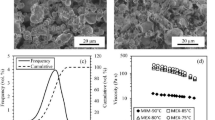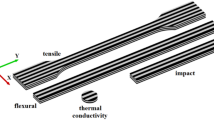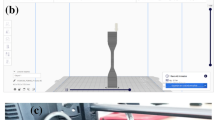Abstract
Among all 3D printing technologies, material extrusion is used predominantly because of its ease of operation and compatibility with versatile polymers. However, the material extrusion process has some inherent disadvantages such as porosity inclusions which limit the potential application of the process in the fabrication of functional parts. The present work aims to investigate the influence of porosity on the geometric accuracy of a 3D printed specimen fabricated using material extrusion process. A numerical model, incorporating void porosity, was developed to simulate the layer-by-layer material deposition, using sequential element activation/deactivation. An experimental study is performed to estimate the porosity in a 3D printed part under specific conditions and validate the numerically estimated deformation in the specimen. The modified 3D inherent strain approach was applied to deduce the residual stresses and deformation in the 3D printed specimen. A parametric study was performed on the ASTM D638 Acrylonitrile Butadiene Styrene specimen to investigate the effect of production parameters like extrusion temperature, chamber temperature, and extrusion speed on the printed component. From the numerical model, it is concluded that porosity has a strong influence on the process. It is shown that the porous specimen was found to have lower residual stresses due to stress relaxation. It was found that the printing residual stresses reduce by ~77% on optimizing the chamber temperature. Further, an 80% reduction in part deformation was seen with the optimal extrusion temperature. It is also observed that regions with high residual stress concentrations correlate higher deformation and delamination.










Similar content being viewed by others
References
King RH (2017) “Lupins,” Non-Traditional Feed. Use Swine Prod., no. Lm, pp 237–246. https://doi.org/10.1201/9780203711248
Cattenone A, Morganti S, Alaimo G, Auricchio F (2019) Finite element analysis of additive manufacturing based on fused deposition modeling: distortions prediction and comparison with experimental data. J Manuf Sci Eng Trans ASME 141(1). https://doi.org/10.1115/1.4041626
Zhang Y, Chou Y (2006) Three-dimensional finite element analysis simulations of the fused deposition modelling process. Proc Inst Mech Eng Part B J Eng Manuf 220(10):1663–1671. https://doi.org/10.1243/09544054JEM572
Fernandes J, Deus AM, Reis L, Vaz MF, Leite M (2018) Study of the influence of 3D printing parameters on the mechanical properties of PLA. Proc Int Conf Prog Addit Manuf 2018:547–552. https://doi.org/10.25341/D4988C
Chadha A, Ul Haq MI, Raina A, Singh RR, Penumarti NB, Bishnoi MS (2019) Effect of fused deposition modelling process parameters on mechanical properties of 3D printed parts. World J Eng 16(4):550–559. https://doi.org/10.1108/WJE-09-2018-0329
Yardimci MA, Güçeri S (1996) Conceptual framework for the thermal process modelling of fused deposition. Rapid Prototyp J 2(2):26–31. https://doi.org/10.1108/13552549610128206
Armillotta A, Bellotti M, Cavallaro M (2018) Warpage of FDM parts: experimental tests and analytic model. Robot Comput Integr Manuf 50(September):140–152. https://doi.org/10.1016/j.rcim.2017.09.007
Croccolo D, De Agostinis M, Olmi G (2013) Experimental characterization and analytical modelling of the mechanical behaviour of fused deposition processed parts made of ABS-M30. Comput Mater Sci 79:506–518. https://doi.org/10.1016/j.commatsci.2013.06.041
Zhang J, Wang XZ, Yu WW, Deng YH (2017) Numerical investigation of the influence of process conditions on the temperature variation in fused deposition modeling. Mater Des 130:59–68. https://doi.org/10.1016/j.matdes.2017.05.040
Vanaei HR, El Magri A, Rastak MA, Vanaei S, Vaudreuil S, Tcharkhtchi A (2022) Numerical–experimental analysis toward the strain rate sensitivity of 3D-printed nylon reinforced by short carbon fiber. Materials (Basel) 15(24). https://doi.org/10.3390/ma15248722
Sood AK, Ohdar RK, Mahapatra SS (2010) Parametric appraisal of fused deposition modelling process using the grey Taguchi method. Proc Inst Mech Eng Part B J Eng Manuf 224(1):135–145. https://doi.org/10.1243/09544054JEM1565
Brown S (1993) Simulation of solid freeform fabrication. Solid Free Fabr Symp 1993:143–149 Available: http://utwired.engr.utexas.edu/lff/symposium/proceedingsArchive/pubs/Manuscripts/1993/1993-17-Brown.pdf
GL and EO, Bugeda G, Cervera M (1995) The “Finite element method”. Rapid Prototyp J 1(2):13–23. https://doi.org/10.1007/978-3-540-73764-3_1
Vanaei HR, Khelladi S, Deligant M, Shirinbayan M, Tcharkhtchi A (2022) Numerical prediction for temperature profile of parts manufactured using fused filament fabrication. J Manuf Process 76(August 2021):548–558. https://doi.org/10.1016/j.jmapro.2022.02.042
Jhunjhunwala P, Kishor A, Burela RG, Singh R, Gupta A (2022) Finite element analysis and topology optimization of Ti-6Al-4V hip implant fabricated by laser powder bed fusion process. Proc Inst Mech Eng Part E J Process Mech Eng:1–9. https://doi.org/10.1177/09544089221144189
Ji L, Zhou T (2010) Finite element simulation of temperature field in fused deposition modeling. Adv Mater Res 97–101:2585–2588. https://doi.org/10.4028/www.scientific.net/AMR.97-101.2585
Gonabadi H, Chen Y, Yadav A, Bull S (2022) Investigation of the effect of raster angle, build orientation, and infill density on the elastic response of 3D printed parts using finite element microstructural modeling and homogenization techniques. Int J Adv Manuf Technol 118(5–6):1485–1510. https://doi.org/10.1007/s00170-021-07940-4
X. Wang, L. Zhao, J. Y. H. Fuh, and H. P. Lee, “Effect of porosity on mechanical properties of 3D printed polymers: experiments and micromechanical modeling based on X-ray computed tomography analysis.,” Polymers (Basel), vol. 11, no. 7, Jul. 2019, https://doi.org/10.3390/polym11071154.
Liao Y, Liu C, Coppola B, Barra G, Di Maio L, Incarnato L, Lafdi K (2019) Effect of porosity and crystallinity on 3D printed PLA properties. Polymers 11(1487):1–14. https://doi.org/10.3390/polym11091487
El Moumen A, Tarfaoui M, Lafdi K (2019) Modelling of the temperature and residual stress fields during 3D printing of polymer composites. Int J Adv Manuf Technol 104(5–8):1661–1676. https://doi.org/10.1007/s00170-019-03965-y
Wang X, Zhao L, Fuh JYH, Lee HP (2019) Effect of porosity on mechanical properties of 3D printed polymers: experiments and micromechanical modeling based on X-ray computed tomography analysis. Polymers (Basel) 11(7). https://doi.org/10.3390/polym11071154
Tao Y et al (2021) A review on voids of 3D printed parts by fused filament fabrication. J Mater Res Technol. 15:4860–4879. https://doi.org/10.1016/j.jmrt.2021.10.108
Liang X, Chen Q, Cheng L, Yang Q, To A (2017) a modified inherent strain method for fast prediction of, pp 2539–2545
K. Ravichandran, “Calibrating inherent strain for additive manufacturing an investigation of different subscale geometries,” 2020.
Yilbas BS, Arif AFM (2001) Material response to thermal loading due to short pulse laser heating. Int J Heat Mass Transf 44:3787–3798
Mugwagwa L, Yadroitsev I, Matope S (2019) Effect of process parameters on residual stresses, distortions, and porosity in selective laser melting of maraging steel 300. Metals (Basel) 9(10). https://doi.org/10.3390/met9101042
Author contributions
All authors contributed to the study conception and design. Specimen preparation experiments, data collection, analysis, and manuscript preparation were performed by Pranav Jhunjhunwala and Ankit Gupta. All authors read and approved the final manuscript.
Funding
This work was supported by Shiv Nadar IoE DTU, India.
Author information
Authors and Affiliations
Corresponding author
Ethics declarations
Competing interests
The authors declare no competing interests.
Additional information
Publisher’s note
Springer Nature remains neutral with regard to jurisdictional claims in published maps and institutional affiliations.
Rights and permissions
Springer Nature or its licensor (e.g. a society or other partner) holds exclusive rights to this article under a publishing agreement with the author(s) or other rightsholder(s); author self-archiving of the accepted manuscript version of this article is solely governed by the terms of such publishing agreement and applicable law.
About this article
Cite this article
Jhunjhunwala, P., Gupta, A. Effect of porosity on the quality of 3D printed structures. Int J Adv Manuf Technol 127, 899–909 (2023). https://doi.org/10.1007/s00170-023-11592-x
Received:
Accepted:
Published:
Issue Date:
DOI: https://doi.org/10.1007/s00170-023-11592-x




